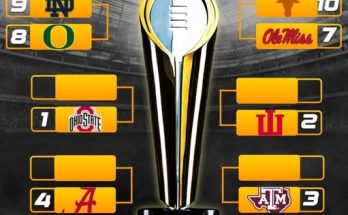There’s been zero drop-off in recruiting under Alabama head coach Kalen DeBoer, a statement that has only grown more valid with each passing week. When Nick Saban retired, many wondered if Alabama would retain its identity as a powerhouse in both recruiting and on-field dominance. After all, Saban wasn’t just a legendary coach—he was the architect of a modern dynasty, a relentless recruiter, and the face of Alabama football for nearly two decades. But in the early stages of the DeBoer era, it’s become increasingly clear that the Crimson Tide is still very much a force to be reckoned with. As of now, Alabama holds six commitments and ranks No. 12 nationally in the On3 recruiting rankings—a testament to DeBoer’s smooth transition and early success in sustaining the program’s elite standards.
Critics initially questioned whether DeBoer, coming from Washington, would be able to resonate with top-tier talent in the hyper-competitive SEC recruiting landscape. But those doubts are quickly being put to rest. DeBoer hasn’t just adapted—he’s thrived. He brought with him a vision, a dynamic offensive system, and an elite-level coaching staff that understands the expectations in Tuscaloosa. Most importantly, he embraced the immense pressure that comes with leading Alabama, and he’s shown he can handle it without flinching. The current recruiting momentum is evidence of that, and it suggests a bright future ahead.
The six commitments on board so far span key positions, addressing both immediate needs and long-term development goals. Rather than scrambling to play catch-up following Saban’s departure, DeBoer and his staff wasted no time in building relationships, reinforcing Alabama’s brand, and selling the vision of a new era—one that honors the past while innovating for the future. What’s especially impressive is how quickly DeBoer has been able to build trust with recruits and their families. In today’s landscape, where name, image, and likeness (NIL) deals factor heavily into decisions, that trust is crucial. DeBoer and Alabama have leveraged the program’s legacy and proven development track record while embracing the changes in college football.
Recruiting isn’t just about landing five-stars. It’s about building a cohesive class, identifying program fits, and developing players into elite contributors. The early commits under DeBoer show a blend of athletic upside, positional versatility, and high football IQ. These aren’t just raw talents—they’re players who fit into the system Alabama is installing and the culture DeBoer is cultivating. The staff has been active and visible, showing up at key camps, connecting on social media, and continuing Alabama’s tradition of staying aggressive in pursuit of the best talent nationwide. They’ve also done a commendable job within the state of Alabama—long considered the Crimson Tide’s home turf—ensuring that top local talent remains close to home and part of the tradition.
In a cycle that many assumed would see Alabama take a step back due to coaching turnover and fierce competition from programs like Georgia, Ohio State, and Texas, the Crimson Tide is instead holding firm. A top-15 ranking at this point in the cycle is a strong indicator of what’s to come. It also positions Alabama to surge even higher as official visits ramp up and elite prospects move toward final decisions. Historically, Alabama has been a dominant force in closing strong, and DeBoer’s recruiting structure appears capable of continuing that trend.
One of the major advantages DeBoer brings is his offensive pedigree. As the architect of one of the most explosive passing attacks in college football during his time at Washington, DeBoer has quickly piqued the interest of quarterbacks, wide receivers, and skill-position players who envision themselves flourishing in his scheme. Several top-tier offensive recruits have named Alabama as a finalist or placed the Tide in their top schools, citing DeBoer’s reputation for development and creative play-calling. The energy around the program feels fresh but still carries the gravitas of Alabama’s championship DNA.
The presence of returning assistants and new hires has also paid dividends. By blending experience with innovation, Alabama has maintained continuity while injecting new life into its recruiting operations. That duality has helped bridge the gap between the Saban era and the DeBoer era, assuring recruits that the standard remains the same—even as the face of the program changes. And make no mistake, DeBoer has fully leaned into the high expectations. Rather than shy away from comparisons or burdens of history, he’s using them as fuel. The recruiting board reflects that ambition, targeting the same caliber of player that Alabama has always pursued: the best.
Moreover, Alabama’s use of NIL has been steady and strategic. While not as flashy as some other programs, the Tide has emphasized stability, branding, and a long-term value proposition. That approach resonates with families who want more than just immediate paychecks. They want development, exposure, and a path to the NFL. Alabama still offers all of that in abundance, and DeBoer has made it clear that those pillars aren’t changing. Recruits continue to cite Alabama’s player development, track record of NFL draft picks, and competitive environment as reasons for their interest. The combination of elite performance and accountability is a powerful recruiting pitch, and DeBoer hasn’t missed a beat in delivering it.
What stands out most in the DeBoer-led recruiting efforts is the attention to detail. From graphics to campus visits, every element of the recruiting experience is tailored to reflect both Alabama’s championship pedigree and the new leadership’s forward-thinking approach. DeBoer and his staff are engaging, transparent, and organized—three traits that are critical in closing elite prospects. The six current commits are expected to be just the beginning, with Alabama in the thick of several major battles that could elevate the class into top-five territory by the fall.
As the summer heats up and official visit season hits full stride, Alabama is poised to make more noise. Several elite prospects have visits lined up, and the buzz around campus is growing. Prospects want to see how Alabama’s identity evolves under DeBoer, and all indications so far suggest it will evolve in the right direction. The recruiting calendar may be changing, but Alabama’s presence remains the same: dominant, strategic, and relentless.
There’s also an element of hunger that’s easy to sense from this new staff. They’re not resting on Alabama’s laurels—they’re working like a team with something to prove. That mindset has clearly translated into their recruiting efforts, where energy, responsiveness, and innovation are key. Recruits are noticing the difference, and they’re responding positively. That, perhaps more than anything, signals that Alabama isn’t going anywhere. The crown may be heavy, but DeBoer and his team seem eager to carry it.
In just a few months, DeBoer has gone from being a question mark in SEC circles to a coach that rivals are beginning to respect and fear. The six early commitments are foundational, and more are on the way. And while it’s too soon to draw definitive conclusions about his long-term impact, the early returns are undeniably encouraging. Alabama football still looks like Alabama football. The machine hasn’t slowed—it’s simply under new management. And that management has proven more than capable of steering the Tide into another dominant era.
The future is being built in Tuscaloosa brick by brick, commit by commit. And if this recruiting class is any indication, Kalen DeBoer isn’t just continuing the Alabama legacy—he’s ready to enhance it.



